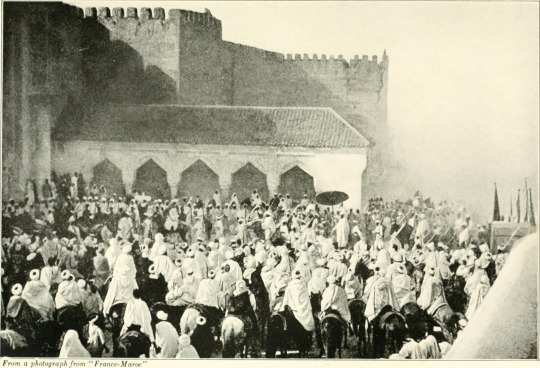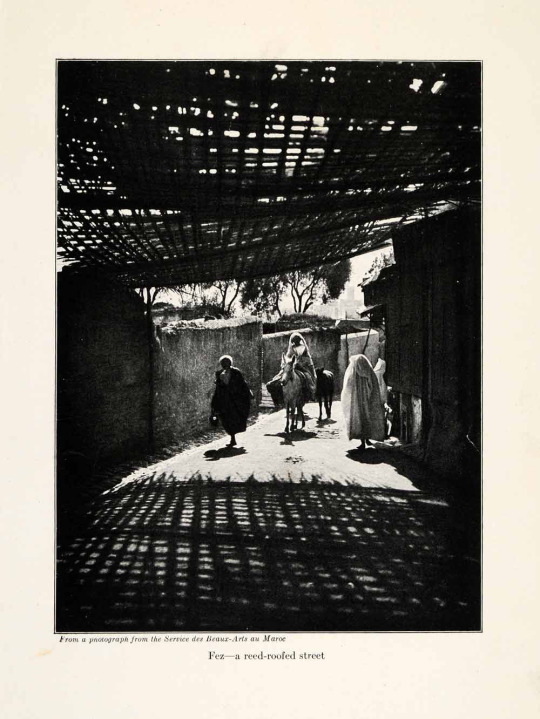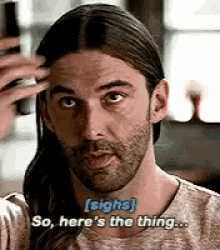#guerrilla style interior decorating
Explore tagged Tumblr posts
Text
Worldbuilding | Morocco, 1920



Trauma
In the 1920s, Morocco was not having a particularly good time. In 1921, tension between colonial Spanish forces and Rif peoples in northern Morocco culminated in a series of guerrilla attacks led by Berber leader Abd el-Krim on Spanish fortifications in June–July 1921. Within weeks, Spain lost all of its territory in the region. This would come to be known as the Rif war. The Rif War lasted from June 1921 to May 1926, when Spanish forces regained the territory they had lost in 1921 and subsequently "won." About 43,500 Spanish troops were killed or wounded or went missing during the war; Spain’s ally France counted about 18,000 as killed, wounded, or missing. Rif casualties may have been about 30,000, with 10,000 killed.
The Rif War was the last major confrontation during several centuries of conflict between the Rif peoples of northern Morocco and the Spanish. Historians debate whether the Rif War is better understood as a secular insurgency against a colonial power or a war in defense of Islam and Berber independence. The war was mainly fought in the northern mountains of Morocco, known as the Rif, however it is not considered to be part of the Atlas Mountain System.
In addition to this, the French colonials settled in 1912, which would come to be known as the French protectorate in Morocco or more simply, French Morocco. France established a protectorate over Morocco as a result of the signing of the Treaty of Fez on March 30, 1912. Prior to 1912, Morocco had been an independent kingdom for several centuries. This would last for 46 years, until 1956.
Geography
North Africa has three main geographic features: the Sahara desert in the south, the Atlas Mountains in the west, and the Nile River and delta in the east. The Atlas Mountains extend across much of northern Algeria, Morocco, and Tunisia. The most notable of these is the Sahara desert.
Architecture
Moroccan architecture in the 1920s incorporated natural elements like stucco, tilework, pise, brick, and marble, which provided beautiful, durable foundations. Tilework is often used to create colorful mosaics that can be used to decorate floors and walls, as well as significant areas in mosques or courtyards, like fountains. The Amazigh built traditional kasbahs and fortifications in the high mountains and desert. Their architectural style is characterised by imposing buildings made from pise, or red mud clay bricks that have been dried in the sun. Additionally, it was not uncommon to see reed-roofed streets and intricately decorated structures whilst walking through town. This ancient Moroccan architectural style is most prevalent in the Atlas Mountains. There, Amazigh villages and kasbahs made with red clay bricks that make a striking contrast to the blue sky. One of the most impressive is Ait Benhaddou in Ouarzazate. Built in the 1600s, this fortified village is made of clay buildings surrounded by defensive walls. The sheer size and asymmetrical structure of this village make it a truly spectacular site.
Morocco had witnessed a long line of invaders including Saharans, Phoenicians, Romans, Greeks, Byzantines, Ottomans, Arabs, Spanish and French. The region was conquered by Muslim Arabs by the 7th century and since then, Islam had the most significant impact on Moroccan architecture. Islamic architecture is highly decorative and functional, characterised by geometric patterns, tiles, fountains, horseshoe arches, and floral arabesques carved into stone or wood. Traditional Moroccan tiles (Zellij) were introduced, with spectacular geometric tiles lining the interiors and exteriors of buildings across Morocco. The classic colours are green, blue, brown, white, and black. Fountains are an integral part of Islamic Moroccan architecture, as they represent paradise. They’re also a place where Muslims can perform purification rituals before prayers. By the 8th century, the Moors were greatly influencing Moroccan architecture. The Moors occupied parts of Spain and Morocco for centuries, so aspects of Spanish architecture became entwined with Islamic and African influences. Some distinctive Moorish influences include the white stucco facades, red-tiled roofs, and elements from Art Deco and Art Nouveau styles. The Moors were also known for their clover-shaped and cusped arches, interior garden courtyards, and hand-glazed tiling.
When the French colonised South Morocco from 1912 to 1956, they introduced elements of French design to Moroccan architecture. One of the most distinctive changes was the windows. While Berber and Islamic architecture used small windows, the French brought in their large double French doors and windows. The French also introduced restrictive building standards. They decreed that buildings could not be higher than four stories and all building roofs should be level and flat. Balconies could not overlook neighbours and each planned area should have 20% of the land dedicated to outdoor gardens or courtyards. While these policies were aimed at preserving the country’s existing traditional architecture, they also stalled urban development in many areas and repressed architectural innovations.
0 notes
Text
For Inside There Is Love
Veth was the first person to see Caleb’s room, other than Caleb himself of course.
It’s not like he was trying to hide it. After all, he made their rooms attached to each other by the lab on purpose right? Conjoined, to some degree. Veth assumed it was like that for a reason. Perhaps a subtle cry for connection?
Regardless, when she slowly snuck into his room while he was still downstairs in the library, curiosity burning to see what he had created for himself, she found her heart breaking just a bit.
It was empty. Blank. Completely devoid of all of the love and devotion that he had filled every other room with. Sure, there was furniture there, and Veth could recognize that the rustic zemnian style was probably somewhat homely to the wizard, but beyond that…
It was apparent what Caleb’s room said about himself.
The Tower was a love letter to all of his friends. And regardless of all her best efforts… Caleb did not love himself.
Veth stood in the dark room, heart aching for her friend for far too long before she very quietly left, closing the door behind her.
She couldn’t let this stand. She had to do something. ***
Jester was the second person to see Caleb’s room. She brought the adorable looking children’s book to Caleb to request the spell that would let her read it, but instead, Caleb offered to read it to her, which was just so very sweet.
And then, he led her into his room, which was blank and boring and empty. She didn’t understand at first. Everyone else’s rooms were so cool! So she told him plainly just how boring it was.
“Well, that took a lot of effort for you all, so no time for me,” he muttered, looking down at the book in his hand. Jester only had a moment to consider what he was saying and the terrible realization that followed, when Caleb continued hastily. “Okay, so this is meant for children.”
Jester nodded her head slowly in acknowledgment, letting Caleb pull the topic away from his room and to the book she had brought. Still, her heart was sad as she listened to him begin to read, his accent dancing over the words beautifully.
When she left that night, her thoughts were on the soft way Caleb read to her, and a forest full of dancing cats. However, the next morning dawned, and as she looked around her own room, so full of love and careful detail, she couldn’t help but remember the empty, bare walls of Caleb’s own suite.
She glanced over at her window, recreating the view from her childhood bedroom, but in beautiful stained glass. Her heart ached as she remembered that Caleb hadn’t even put a stained glass window over his fireplace, the way he had for everyone else.
Literally everyone had a stained glass window. But he didn’t…
“Welp!” Jester said to herself as she sat up in bed, “I guess it’s time to change that!” ***
It was hard trying to figure out exactly when to sneak into Caleb’s room. Jester had no idea how long he would be distracted down in the library, and painting took some time, especially if she wanted it to look good. Fortunately, stained glass was a bit easier to manage quickly, but still…
She set up her paints on the mantle of the fireplace and got to work, moving quickly based on a sketch that she had drawn earlier that day. There was only so much she could do, painting on solid wall as opposed to glass, but she made a point to add fake glowing motes of light to give it as close to a glass effect as she could.
She was still scrambling to paint when suddenly, she heard a door slowly open to her right. She froze, turning towards the sound like a cat caught in the food pantry, an excuse already on her lips.
But it wasn’t Caleb. It was Veth.
Veth was sneaking into the suite from the door to the laboratory, a large, plush blanket of vibrant colors and shapes draped over her arm. She froze just as Jester did, watching her for a split second before both women lifted their hands to point at the other.
“What are you doing here?!”
“Why are you in Caleb’s room?!”
They both babbled in tandem at each other for a moment before Jester couldn’t help but laugh. She had asked, but she could tell from the look on Veth’s face and the blanket in her arms exactly why she was here. And with her nearly completed stained glass painting in front of her, she knew that Veth knew what was going on as well.
“Well, I’m glad I’m not the only one at least,” Veth said with a wry smile. Jester stepped down from the fireplace, paintbrush still in hand to look at the blanket that Veth had brought. “It’s from Luc’s room. I’m going to put it on his bed.”
“Oooh, that's a really good idea!” Jester gasped. “I have a whole bunch of extra pillows in my room that I can bring too!”
“Well, it looks like you’ve got a really good idea yourself anyway,” Veth said appreciatively, pointing at the half finished painting. Jester had considered a lot of options, when she had been sketching out how she wanted it to look, but in the end, she had opted for simple but direct.
She was rather proud of it.
“Thank you,” she said somewhat breathlessly. “Wanna help?”
“Hell yeah I want to help!” Read more on AO3
#Critical role#Critical role fan fiction#critical role fan fic#cr fan fiction#cr fan fic#caleb widogast#Widogast's Nascent Nein-Sided Tower#found family#recovery#guerrilla style interior decorating#self-loathing Caleb Widogast#The Mighty Nein
59 notes
·
View notes
Text
Terminator: Dark Fate
I have no idea how TSCC came up with two seasons’ worth of innovative scenarios about Terminators and these cinematic universe motherfuckers can only redo T2 with more CGI.

This movie is plotless. It has no real plot. It’s like Now That’s What I Call A Terminator Movie! There are so many callbacks and borrowings from all the other Terminator movies that it passes the point of homage and just becomes plagiarism. The bad Terminator is the same as the T-X, metal endoskeleton with a T-1000 shell. They kill him with a Terminator power core. They say Come With Me If You Want To Live and I’ll Be Back (twice! It’s the first thing Sarah Connor says and it makes no sense in context, it’s just something people say in Terminator movies). In fact, it has anti-plot, since it undoes a lot of the story developments in Terminator and T2.
The premise is basically just we’re going to remake Terminator 1, but people don’t like reboots, so we’re going to bring back Linda Hamilton and make it a technically kinda sorta sequel (sure, Skynet was wiped from existence, but another, completely different, yet exactly the same AI called Legion was created and did the exact same thing. Which also happened in T3, but they had the decency to still call it Skynet). But otherwise, it’s entirely people being chased by an evil robot from the future and trying to destroy it.
That’s it. That’s all there is to it. T2 had the whole thing about preventing Judgment Day before it happened. T3 had Judgment Day actually happen. This one, nothing. There is nothing going on under the surface other than a bunch of action sequences and explosions. Even T3 got some mileage out of the idea that Judgment Day was inevitable. Here, our cast learns that Judgment Day was already ‘averted’ once slash that it’s destined to be repeated and they basically go “Eh. Figures.” I’m not kidding.
Wait, that’s not fair. Let’s count out the TWEEESTS.
1. In a very contrived way, the script waits an hour and a half to actually explain why heroine Dani has been targeted for termination--you know, the thing Kyle Reese explained to Sarah Connor the moment they were out of danger--all to set up this big ‘reveal’ that Dani isn’t the NuSarah, she’s the NuJohn (yes, they actually say this aloud, just so you soup sandwich motherfuckers in the audience get it). Hear that, neckbeards, John Connor is now a woman! And Mexican! And she’s got a bit of a gay vibe, because it’s 2019 and God forbid we have a heroine that isn’t a bit bicurious. If she has a cock and balls, my bingo card will be a winner.
2. Months after killing John Connor and thus completing his mission, an Arnold-model Terminator started a family (wow, that was quick) and learned the value of human life and eventually switched sides. This is a crazy new idea that also happened in Terminator: Genebissss, so it’s done and dusted in ten minutes, even though Arnold is the most engaging character. (He’s saddled with a lot of yuk lines about how he’s a comically serious Terminator, yet (teehee) works as an interior decorator, but at least he has a personality.)
3. The other good Terminator is Grace, who needs meds to keep up her cyborg strength or she’ll crash (this never affects the plot) (it’s like they read something about Rey Palpatine having no flaws and so they decided to give Grace the ‘flaw’ of literally having her own Kryptonite). She’s not a Terminator, she’s an augmented human, which means she can make MCU-style wisecracks every five minutes. (”I didn’t hear anything.” “That’s because you’re not a cybernetic super soldier from the future.” Actual dialogue.)
4. Linda Hamilton is back, baby! Yes, that’s right, they dragged her away from doing guest spots on Lost Girl! Can you believe???? She’s become a Terminator hunter that ambushes Terminators as they come back from the future and destroys them, because Skynet was both able to send back an infinite number of Terminators AND because now they can easily be destroyed by one five-hundred-year-old woman.

This makes it a bit confusing why they have so much trouble taking out Ghost Rider, given that he’s a T-1000 skin with a creamy T-800 center. It seems like if you hammer him enough, he’s got no endoskeleton, and that’s all she wrote. That’s what happened to the T-X. Can his liquid metal skin just walk around without the other half of him? If so, what’s the point of the endoskeleton? The T-1000 managed without it and that seemed a lot harder to kill. At one point, Sarah hits the bare endoskeleton with a bazooka, which seems like it should’ve been a mortal blow, but it’s the first act, so I guess not.
And is it supposed to be funny that the opening takes place in a car factory where (in 2019!) the human workers are losing their assembly line jobs to machines? Because they’re all Mexicans? None of them ever look at a Terminator and go THEY TOOK OUR JOBS, but man, that one is all teed up for the Rifftrax boys.
For a movie with, as I said, no plot, it’s very rushed. They seem to be saying “yeah, it’s a dumb Terminator movie, you know the score,” (even tho it’s halfway aimed at people who aren’t Terminator fans; more on that in a minute) because it seems to take all of ten minutes for both good guys and bad guys to find Dani and start getting into CGI stunt double fights, which means the story has very little time to breathe and we have very little time to get to know any of the characters. The bad guy spawns practically at Dani’s front door! And pretty much does everything by massacring a bunch of people and then hacking a computer. The T-1000 had some intelligence, some charisma. This guy’s a big nothing.
And the Dani character is useless. She starts the story already super assertive, is barely traumatized at all by her loved ones being killed and her own life being endangered. There’s none of that relatable feel of an everyman suddenly being told they have a grand destiny and an incredible responsibility, because right from the start she’s standing up to her mean boss and doing the Nevertheless She Persisted thing. And all this while being literally five feet tall and looking all of twelve years old.

I love these Spy Kids movies.
And at least the original two movies were smart enough to leave the future John Connor mostly to the imagination. This one actually shows us Dani as grizzled military badass, beating up guys and delivering inspiring speeches (would it surprise you to know that humans fighting among each other “is exactly what Legion wants”?), and it’s just--oh man. If ever a political leader is enough to make people think back to the good old days of Trump and Biden...
And if we’re going to talk shit (rightfully) about Jai Courtney’s Kyle Reese not being at all scruffy or traumatized or feral, it should be noted that Grace seems pretty well-adjusted for a post-apocalyptic guerrilla fighter (who all wear Starship Trooper uniforms). Aside from a tendency to smash the face in of everyone she comes across, whether they’ve done anything to deserve it or not (Sample dialogue, to a doctor who is looking at her X-rays after performing life-saving surgery on her: “Did I give you permission to look at my private parts?” SMASH. No, really!)
They really go all in on this cringey, woke af “You’re not the mother of some MAN, Dani. YOU ARE THE FUTURE!” And yet, there’s a hilarious amount of toxic masculinity in this movie, just without the dongs. About every other line Sarah and Grace have is generic tough guy bullshit about how they’re going to kick someone’s ass, how they’re suspicious of someone, how they’re hostile towards someone. If they had dongs, you would think they were the smallest dongs possible, because they are compensating for something, BIG TIME. Between the T-800 and Sarah and Grace, everyone in this movie seems to outright hate each other, to the point that Arnold’s killer cyborg is one of the more pleasant characters. It gets to where you just want someone to order a fucking decaf. Does the fact that Sarah Connor has a vagina keep it from being ridiculously over the top how she spends all her time either blowing up robots or drinking herself into a stupor? C’mon. You can’t complain about male characters having ‘man-pain’ then give Bad Grandma a pass over her ovaries.
And that’s it. It’s a Brundlefly shit between yet another dumb girlpower reboot for the people who’ve never seen a Terminator movie and a sequel with Sarah and Uncle Bob to try and get that last drop of blood outta this stone. They’re trying to make something that appeals to both people for whom this is their first Terminator and people for whom this is their latest Terminator and it just doesn’t work. The newbies don’t have any emotional investment in these characters and the Terminator fans don’t like it that all the old movies were rendered meaningless to prop up Grace and Dani.
Hilariously enough, I actually played Terminator: Resistance recently, which is a fun little mid-tier shooter that was meant to tie in to this movie... and it completely ignores all the Dani/Grace/Legion BS to take place in John Connor’s future war and tie in to the first two movies. That’s how forgettable this movie is. Its own damn video game adaptation pretends it doesn’t exist. Fuuuck.
Oh! Oh! Oh! And in that big, bad, sexist original Terminator, which was so unwoke and problematic, Sarah saved herself and finished off the Terminator herself. Here, Dani has to be saved by Arnold at the climax. The 35-year-old movie is more feminist than this one. Fuck you very much.
30 notes
·
View notes
Photo









Monthly Listening: November 2017
My attempt to use this month as some last-minute catch-up period of whatever I missed earlier on the year has gone... Not all that well. Instead I’m playing catch up with new releases, especially from the J-pop and K-pop sphere of music. November has surprisingly been an impressive time for new albums! That said, it looks as though I’ve been amazed more by albums not from this year.
Oh, and did you know I put together a list for all of my favorites not from 2017? I know it’s still a bit early for year-end content, but it felt right to post it before I roll mine out. You can check it out here.
The highlights from this month:
Ikue Mori -- Hex Kitchen (1995)
Metro Area -- Metro Area (2002)
Ame to Kanmuri -- nou (2017)
Gang Parade -- Gang Parade Takes Themselves Higher!! (2017)
Alex Lahey -- I Love You Like a Brother (2017)
Tokyo Girls’ Style -- PERIOD.BEST ~Kimete Iiyo Watashino Koto~ (2017)
Kelis -- Wanderland (2001)
DJ Assault -- Off the Chain for the Y2K (2001)
Deee-Lite -- World Clique (1990)
And the rest:
2017 albums
21 Savage, Offset & Metro Boomin’ -- Without Warning
Alex Lahey -- I Love You Like a Brother
All Pigs Must Die -- Hostage Animal
Ame to Kanmuri -- nou
Astro -- Dream, Pt. 2
Baths -- Romaplasm
Bell Witch -- Mirror Reaper
Bibio -- Phantom Brickworks
BiSH -- The Guerrilla BiSH
Bjork -- Utopia
The Black Madonna -- RA.600 podcast
Blue Hawaii -- Tenderness
The Body & Full of Hell -- Ascending a Mountain of Heavy Light
Bruce -- The Hydra Present Hessle Audio 10
Call Super -- Arpo
Celestial Trax -- Nothing Is Real
Converge -- The Dusk in Us
Dustin Wong & Takako Minekawa -- Are Euphoria
dvsn -- Morning After
Equiknoxx -- Colon Man
Errorsmith -- Superlative Fatigue
EXID -- Full Moon
Fatima al Qadiri -- Shaneera EP
For Tracy Hyde -- He(r)art
Full of Hell -- Trumpeting Ecstasy
G-Worthy -- G-Worthy
Gang Parade -- Gang Parade Takes Themselves Higher!!
Godflesh -- Post Self
Guso Drop -- Painfully Violent
Helena Hauff -- Have You Been There, Have You Seen It EP
JBJ -- Fantasy
Joe -- Truancy Vol. 193
Kamaiyah -- Before I Wake
Karen Gwyer -- Rembo
Kenshi Yonezu -- Bootleg
King Krule -- The Ooz
Laraaji -- Bring on the Sun
Lee Ann Womack -- The Lonely, the Lonesome & the Gone
Lovelyz -- Fall in Lovelyz
M.E.S.H. -- Hesaitix
Majid Jordan -- The Space Between
Mavis Staples -- If All I Was Was Black
Molly Brazy -- Molly World
Monster X -- The Code
Nazoranai -- Beginning to Fall in Line Before Me, So Decorously, the Nature of All That Must Be Transformed
The New Pornographers -- Whiteout Conditions
Quicksand -- Interiors
P-Lo -- More Than Anything
Passepied -- Otonari-san
Polkadot Stingray -- Zenchi Zennou
Rabit -- Les Fleur du Mal
Red Velvet -- Perfect Velvet
Seventeen -- Teen, Age
Shabazz Palaces -- Quazarz vs. The Jealous Machine
She Is Summer -- Swimming in the Love EP
She Is Summer -- Water
Shiritsu Ebisu Chugakko -- Ebicracy
Slaughter Beach, Dog -- Birdie
Special Request -- Belief System
Tokyo Girls’ Style -- PERIOD.BEST ~Kimete Iiyo Watashi no Koto~
Ty Dolla Sign -- Beach House 3
Uniform -- Wake in Fright
Visionist -- Value
Yaeji -- EP2
Yukueshirezu Tsurezure -- Antino Mideology (Kaishiki)
Yunomi -- Yunomiq
Ziur -- U Feel Anything?
Non-2017 albums
BTS -- Skool Luv Affair
BTS -- The Most Beautiful Moment in Life, Part 1
BTS -- The Most Beautiful Moment in Life, Part 2
Chakra -- Satekoso
Da Brat -- Anuthatantrum
Deee-Lite -- World Clique
Deftones -- Around the Fur
Destiny’s Child -- Destiny Fulfilled
Destiny’s Child -- Survivor
DJ Assault -- Off the Chain for the Y2K
The Firm -- The Album
Ikue Mori -- Hex Kitchen
Kelis -- Wanderland
Metro Area -- Metro Area
Namie Amuro -- Break the Rules
Neon Bunny -- Stay Gold
Queens of the Stone Age -- Rated R
Quicksand -- Slip
Romeo Santos -- The Formula, Vol. 2
Smog -- Red Apple Falls
T.I. -- I’m Serious
Yukueshirezu Tsurezure -- Post Catastrophe
0 notes
Text
Hyperallergic: A Glimpse Inside the Street Art–Themed 5Pointz Condos
Rendering of the front desk area of the forthcoming 5Pointz condos (all images courtesy Mojo Stumer)
The site of the former, world-famous graffiti mecca known as 5Pointz is undergoing a gradual transformation as two luxury residential towers rise on the corner of 22-44 Jackson Avenue in Long Island City. What’s currently a few dozen stories of scaffolding and skeletal walls will, likely by the end of this year, be a pair of sleek, 48- and 41-floor buildings. They’ll carry the 5Pointz name, thanks to Jerry Wolkoff, owner of the development company G&M Realty, which in 2015 successfully registered the brand with the state of New York after previous, failed attempts to trademark it. Their interiors, too, will reflect the lost outdoor museum by featuring street art–style decorations.
Rendering of interior of forthcoming 5Pointz condos
G&M Realty hired architectural firm Mojo Stumer Associates to design the 1,115-apartment project, as Curbed first reported, and recently shared renderings of what’s to come. Stylized echoes of the original guerrilla art hub dot the common areas, from engraved signs of the new buildings’ logo — which spells out “5Pointz” in wildstyle lettering — to plenty of graffiti-inspired wall art that decorates stairwells and lounges.
“The client requested that graffiti artwork be incorporated throughout the interiors to reflect back on the history of the 5 Pointz neighborhood,” Mojo Stumer said in a statement.
The designs represent just one more example of real estate developers coopting street art as a selling point — see the forthcoming Banksy-themed rentals in, of course, Bushwick, or the gallery of murals at Four World Trade Center, soon to become Spotify offices. But 5Pointz’s interior choices are less an homage to the past than a blatant attempt to capitalize on the legacy of the artists its developer screwed over. In 2013, two dozen artists who had contributed works to the exterior of the now-razed warehouse woke up to find their pieces whitewashed overnight, under the orders of Wolkoff, who had given them no notice. As the owner of the building, Wolkoff had allowed the artists to freely paint there for years; as Hyperallergic previously reported, some members of 5Pointz saw the buffing as his attempt to prevent the site from attaining landmark status.
Rendering of the gym in the forthcoming 5Pointz condos
The artists filed a federal lawsuit against Wolkoff for destroying their works, and this past March, a judge ruled that their case will move forward in a jury trial. As the New York Times reported, a lawyer representing the group has argued that their lost creations fall under the Visual Artists Rights Act of 1990, which protects established artists whose public art on someone else’s property is of “recognized stature.” Wolkoff contends that the artists knew he ultimately planned to tear down the warehouse to build high-rises, and he told the Times that he cried when the building came down.
Wolkoff intends to continue giving artists space to work at his forthcoming 5Pointz rentals. The buildings will contain 20 studios, and street artists will be invited to come and paint — although “the ones who sued me,” Wolkoff told the Times, “are not invited back.” It’s unclear if those who take him up on the offer will be paid.
Rendering of interior of forthcoming 5Pointz condos
Rendering of interior of forthcoming 5Pointz condos
Rendering of interior of forthcoming 5Pointz condos
Rendering of swimming pool of forthcoming 5Pointz condos
The post A Glimpse Inside the Street Art–Themed 5Pointz Condos appeared first on Hyperallergic.
from Hyperallergic http://ift.tt/2sdw8Cu via IFTTT
0 notes
Text
Hyperallergic: The Multifarious Feminism of the Whitney Biennial
Aliza Nisenbaum, “MOIA’s NYC Women’s Cabinet” (2016) (photo by Benjamin Sutton/Hyperallergic)
Could we consider the 2017 Whitney Biennial a feminist exhibition? Twenty-five of the 63 artists in the show are women. There are additional women in the participating collectives and more exhibitors who are gender fluid. The percentage isn’t as high as in 2010, when there were more women than men in the show, but certainly better than in 2014, when women made up only 32%. Even when they haven’t been included, feminists have played a critical role in the biennial, critiquing the show for its lack of diversity. Groups such as the Ad Hoc Women Artists’ Committee and the Guerrilla Girls have protested the exhibition over the decades.
The versions of feminism on display in the current biennial are incredibly rich and varied. Among the most beguiling and subtly transfixing are the digital interventions of Porpentine Charity Heartscape. In her seven web-based games, installed on desktop computers in a small, darkened room, viewers encounter text-based questions and worlds that prompt emotionally manipulated responses, leaving us either unnerved or enthralled. In one game, you feeling your anxiety rise as the empty, dark intervals seem to lengthen between text bursts about the isolation of a hospital stay.
Porpentine Charity Heartscape and Neotenomie, “With Those We Love Alive” (2014), hypertext (image courtesy the artists)
The biennial also features works by several lesbian artists — Celeste Dupuy-Spencer, Carrie Moyer, and Ulrike Müller — associated with the LTTR Group (the acronym originally stood for “Lesbians to the Rescue,” then changed to “Listen Translate Translate Record,” and then just became their collective moniker). The LTTR Group is a genderqueer collective founded in 2001; it produced an annual feminist art journal for five years, changing its name and editorial staff with each issue. At the Whitney, the Austrian-born Müller has contributed a wool rug with a black cat in a field of geometric designs; the feline as a wry, lesbian pussy joke takes on broader implications in the politicized milieu of 2017, when the pink pussy hat became the de rigueur fashion statement for the January Women’s March in response to a statement by our now president.
Works by Ulrike Müller in the Whitney Biennial (photo by the author for Hyperallergic)
Müller also has a set of small abstract paintings on paper with some transparency, in dialogue with densely opaque enameled paintings installed in a nearby hallway. Though there are color and shape differences between the two groups, the forms are consistently simple, curvy, and gorgeous. Moyer has filled a room with large acrylic-on-canvas paintings in her signature butterfly and nonobjective compositions. Recalling Color Field painting, the works suggest luxurious, diaphanous curtains featuring super sexy, psychedelic, even tender forms, with occasional accents of glitter. Abstraction can be a strong vehicle for feminism, and has been recognized as such since the beginning of the second wave of feminist art. Müller taps into this by combining a strong and potent color sensibility with an undoing of the harsh and drastic modernist ideogram; she adds flair and drama that earlier modern artists would never have allowed. Moyer’s dense surfaces recall surrealist spaces, but rendered as abundant, decorative spreads and sprays.
Works by Carrie Moyer in the 2017 Whitney Biennial (photo by Benjamin Sutton/Hyperallergic)
Meanwhile, Dupuy-Spencer probes the present more explicitly. While many visitors seem to gravitate toward her depiction of a Trump rally, I was mesmerized by her pencil drawing titled “Matriarchs of the Hudson Valley (1980s-90s)” (2016), which looks like an update of a Sylvia Sleigh painting. Here, Dupuy-Spencer glorifies a homey, soft lesbian world, a sharp contrast to the butch pleasures and intensities of the nearby and much larger acrylic painting “Veteran’s Day” (2016). In the latter, she interrupts the femme associations of the flowered yellow wallpaper by showcasing a framed photograph of soldiers in salute, as well as a framed newspaper clipping from which Cassius Clay peers out — with volumes by Lorca, Lorde, and Sontag pictured on the bookshelf, for further contrast.
Celeste Dupuy-Spencer, “Veteran’s Day” (2016) (photo by the author for Hyperallergic)
An intersectional critique of how sexuality and race connect with gender comes into play in the work of several artists in the biennial. Like Dupuy-Spencer, the Latinx artist Aliza Nisenbaum works in an expressive, figurative style. Nisenbaum’s paintings are clearly informed by a knowledge of recent developments in her medium; among other references, they recall for me Sleigh’s work and the decorative motifs in the background of Joyce Kozloff’s art. Nisenbaum’s “MOIA’s NYC Women’s Cabinet” (2016) locates her immigrant sitters in a composition which draws upon the long tradition of group portraiture, a format historically reserved for the elite. Nisenbaum’s women dominate the painted space, and she emphasizes their individual beauty, collective strength, and social potency and vibrancy as a group, bolstered by colors and patterns. Her brand of feminist art offers a reprieve from the often harsh realities of immigrant life.
In another gallery, three video monitors display pieces of a multiyear project, Liquor Store Theatre, by Detroit-based artist and choreographer Maya Stovall. Three African American women dancers, including Stovall, make slow, balletic movements on sidewalks in front of various liquor stores. Under brightly lit signage, the artist intermittently interviews residents about life in Detroit. Her portraits of the gritty urban landscape are marked by the bustle of its residents’ everyday movements; the liquor stores are loci of these communities. Stovall heightens, brightens, and saturates the colors to draw out beauty from these otherwise unremarkable settings.
vimeo
Maya Stovall, “Liquor Store Theatre, vol. 1, no. 3”
Deana Lawson’s photographs have long been a personal favorite. She crafts highly determined situations and places figures in elaborately arranged environments. In “Ringbearer” (2016), a grandmotherly figure sits in an interior space next to a standing young boy, who holds a heart-shaped ring pillow. “Signs” (2016) moves outside to show a group of four shirtless, muscled young men flashing hand gestures resembling gang signs. In her work, Lawson looks at the black body and the life of the black family. I’m particularly fascinated by the way she achieves such a exquisite intensity and range of melanin tones in a medium that has, for most of its history, been antagonistic to black and brown skin.
In the Whitney’s lobby and on its fifth floor, African American filmmaker Cauleen Smith has hung a set of 16 banners from the ceiling. Catalyzed by videos of police shootings, Smith put illustrative but cryptic symbols — showing cameras, pencils, microphones, and eight balls — on one side and sayings on the other. The latter read: “I’m so black that I blind you,” “No wonder I go under,” and “You don’t hear me though,” among other messages. Like Barbara Kruger decades before her, Smith keeps the subject and object in a shifting relationship. Her phrasings perpetuate ambiguity for the viewer about how the action is to be received.
Detail of Cauleen Smith’s “In the Wake” (2017) banners (photo by Benjamin Sutton/Hyperallergic)
In a biennial filled with such multifarious feminism, it’s unfortunate that the most discussed work has been Dana Schutz’s painting of Emmett Till’s murdered body, based on photographs from his open-casket wake in 1955. Schutz, who is white, is considered a feminist artist for her painterly focus on the oft-dismembered or disfigured body, calls herself a feminist, and has been at the center of a dialogue about feminist painting for more than a decade. But what concerns me about her particular brand of white feminism here is that she’s making a spectacle of the body of a black boy — who was murdered due to the lies of a white woman — in order to aggrandize her artistic mission. Her treatment of Till’s horror is superficial as she crudely renders his mangled face as an impastoed clump of paint. It’s gimmicky and bespeaks her own lack of self-awareness.
Feminist art speaks volumes about gender, sexuality, the situation of the body in society, and how those identities and issues intersect with race, class, ability or disability, and other realities. In this way, the 2017 Whitney Biennial offers a window onto some of our most pressing cultural concerns, as well as our shortcomings. There are other important feminist artists who have work in the show, such as Anicka Yi and Beatriz Cortez, and though there could be more, it’s significant that so many are included. In 2005, artist and critic Mira Schor aptly wrote: “Perhaps the most important political act I perform is to identify myself publicly as a feminist.” The women in the biennial proclaim their own feminisms artistically and publicly; in today’s political climate, that feels more important than ever.
The 2017 Whitney Biennial continues at the Whitney Museum (99 Gansevoort Street, Meatpacking District, Manhattan) through June 11.
The post The Multifarious Feminism of the Whitney Biennial appeared first on Hyperallergic.
from Hyperallergic http://ift.tt/2qBmFIV via IFTTT
0 notes